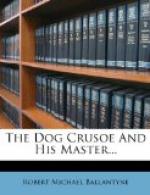“Ha, mauvais dog! bad chien! vill you dare to look to me?”
Crusoe did look with amiable placidity, as though to say, “Howl away, old boy, I won’t budge till Dick does.”
With a mighty effort Giant Sleep was thrown off at last, and the hunters were once more on their journey, cantering lightly over the soft turf.
“Ho, let’s have a run!” cried Dick, unable to repress the feelings aroused by the exhilarating morning air.
“Have a care, boy,” cried Joe, as they stretched out at full gallop. “Keep off the ridge; it’s riddled wi’ badger—Ha! I thought so.”
At that moment Dick’s horse put its foot into a badger-hole and turned completely over, sending its rider through the air in a curve that an East Indian acrobat would have envied. For a few seconds Dick lay flat on his back, then he jumped up and laughed, while his comrades hurried up anxiously to his assistance.
“No bones broke?” inquired Joe.
Dick gave a hysterical gasp. “I—I think not.”
“Let’s have a look. No, nothin’ to speak o’, be good luck. Ye should niver go slap through a badger country like that, boy; always keep i’ the bottoms, where the grass is short. Now then, up ye go. That’s it!”
Dick remounted, though not with quite so elastic a spring as usual, and they pushed forward at a more reasonable pace.
Accidents of this kind are of common occurrence in the prairies. Some horses, however, are so well trained that they look sharp out for these holes, which are generally found to be most numerous on the high and dry grounds. But in spite of all the caution both of man and horse many ugly falls take place, and sometimes bones are broken.
They had not gone far after this accident when an antelope leaped from a clump of willows, and made for a belt of woodland that lay along the margin of a stream not half-a-mile off.
“Hurrah!” cried Dick, forgetting his recent fall. “Come along, Crusoe.” And away they went again full tilt, for the horse had not been injured by its somersault.
The antelope which Dick was thus wildly pursuing was of the same species as the one he had shot some time before—namely, the prong-horned antelope. These graceful creatures have long, slender limbs, delicately-formed heads, and large, beautiful eyes. The horns are black, and rather short; they have no branches, like the antlers of the red-deer, but have a single projection on each horn, near the head, and the extreme points of the horns curve suddenly inwards, forming the hook or prong from which the name of the animal is derived. Their colour is dark yellowish brown. They are so fleet that not one horse in a hundred can overtake them; and their sight and sense of smell are so acute that it would be next to impossible to kill them, were it not for the inordinate curiosity which we have before referred to. The Indians manage to attract these simple little creatures by




